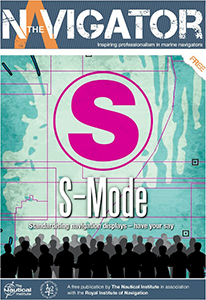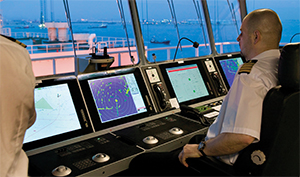Before sunrise on Jan. 13, 2015, the 257-foot Connor Bordelon struck an unmanned drilling platform in the Gulf of Mexico while returning to Port Fourchon, La. The accident caused $500,000 in damage to the 2-year-old offshore supply vessel, and the platform needed $4 million in repairs.
Afterward, the mate steering the OSV told investigators he couldn’t switch from autopilot to manual controls in time to prevent the impact. He also admitted not knowing the autopilot system had a single button to re-engage manual steering.
For the past decade, The Nautical Institute has pushed for greater standardization of bridge navigation electronics to prevent this type of mishap. The London-based organization argues that standardizing these systems will reduce confusion and improve mariner safety.
“The lack of standardization on these safety-critical systems has time and again come up in our member surveys as something they want us to work on,” David Patraiko, director of projects for The Nautical Institute, said in a recent interview.
That effort is now entering a critical stage. In February, the International Maritime Organization (IMO) Subcommittee on Navigation, Communications and Search and Rescue will consider guidelines for a uniform operation mode for bridge navigation equipment. Those hearings could pave the way for new international standards covering myriad navigation electronics, including radar, AIS and ECDIS, as well as integrated bridge controls.
New global guidelines regarding standardization of e-navigation equipment could be in place by 2019. If adopted, U.S.-flagged vessels that meet SOLAS criteria “will see this greater standardization in due time,” Patraiko said.
The Nautical Institute began calling for simplifying navigation equipment a decade ago. The timing coincided with wider adoption of navigation electronics in the wheelhouses of vessels ranging from harbor tugs to containerships and tankers. As the market grew, so did the number of companies offering these systems, all of which operated similarly but with unique interfaces and controls.
The institute initially envisioned a “standard mode,” or S-mode, across different manufacturers’ platforms. Users could press a button to operate the navigation electronics in the separate S-mode setting. There, they would find a standard menu, interface and functionality available in addition to the individual manufacturer’s proprietary platform.
“The concept for S-mode is to create standard features,” The Nautical Institute wrote in 2008 in its magazine Seaways. “S-mode is not envisaged as a simplified or restricted display mode, but instead would offer a high degree of functionality.”
Perhaps most importantly, “these functions would all be standard and anyone trained in the use of S-mode would therefore be competent and confident to make the best use of navigation systems on any ship so equipped,” the institute wrote.
The S-mode concept also has potential impacts for maritime training. International regulations require mariners to be familiar with safety-critical systems aboard their vessels, which is often not possible for crews bouncing from ship to ship and system to system. As The Nautical Institute noted, “it is often the case that the quality of training materials aboard is poor, or that other officers have limited skills or competency to be an effective instructor.”
 |
|
A recent issue of The Nautical Institute’s Navigator magazine included an S-mode survey, with the results presented in a report to the International Maritime Organization. An IMO panel will meet in February to consider new global guidelines to standardize the operation of e-navigation equipment. |
Further, standardizing navigation electronics would simplify shoreside training programs. There are more than 30 bridge electronics makers, and few training facilities have the resources or space to develop training labs for every system. Vessel operators who hire crew trained on a standardized system can be more confident they meet international regulatory standards, Patraiko said.
Over the years, the S-mode effort has gained support from the International Federation of Shipmasters’ Associations, a London-based organization focused on safety at sea. But some major manufacturers of navigation electronics have pushed back against the proposal.
“There has been a fair bit of debate over the past 10 years with some manufacturers, but not all, saying it would inhibit innovation and therefore they didn’t like it,” Patraiko told Professional Mariner. “Others were saying, ‘We have a lot of standardization with aviation electronics and it doesn’t inhibit innovation.’”
Some manufacturers also worry that lower-cost S-mode-based systems would ultimately crowd out proprietary systems.
The international coalition of bridge equipment manufacturers known as Comité International Radio-Maritime, or CIRM, is among the groups that have questioned the S-mode effort. Richard Doherty, deputy secretary-general and chief technical officer, said the organization’s members recognize the needs behind the proposal but consider the S-mode concept “overly prescriptive.”
“We believe it would serve to constrain users and manufacturers,” he said in an email. “Instead, it is our view that the user needs can be met through a more practical approach.”
Recently, The Nautical Institute began working with CIRM to develop a middle-ground solution. This plan, which will be submitted to the IMO before the February meeting, calls for “always on” standardization, meaning there would be uniformity within the user interface rather than a separate operation mode.
“The proposal will significantly increase the standardization of user interface design,” Doherty said. “But by focusing on better standardization of key elements and permitting flexibility beyond those key elements, the proposal ensures that the varied and evolving needs of the user can continue to be met through innovation on the part of the system designer.”
Meanwhile, The Nautical Institute has begun surveying its members to get as much feedback as possible about implementing such a standardized system. The results of the survey will be part of the institute’s presentation to the IMO subcommittee in February.
In addition to the survey, maritime officials from around the world have been corresponding for years about standardizing e-navigation. Bill Cairns, navigation technology director for the American Pilots’ Association (APA), is among the officials participating in that effort. He said the plan remains a work in progress.
“While the APA has been encouraged in the changes from the original S-mode concept to what is now in the draft (guidelines), much work is yet to be done,” he said.

